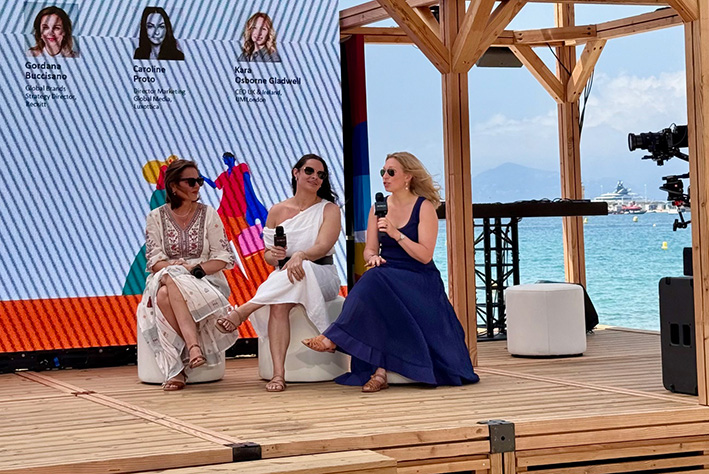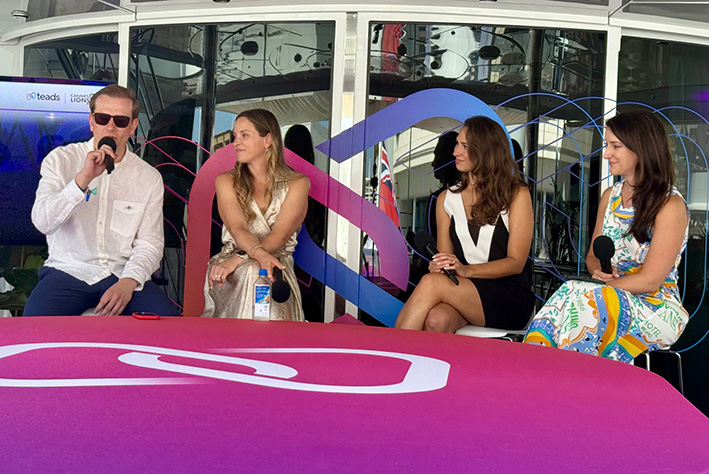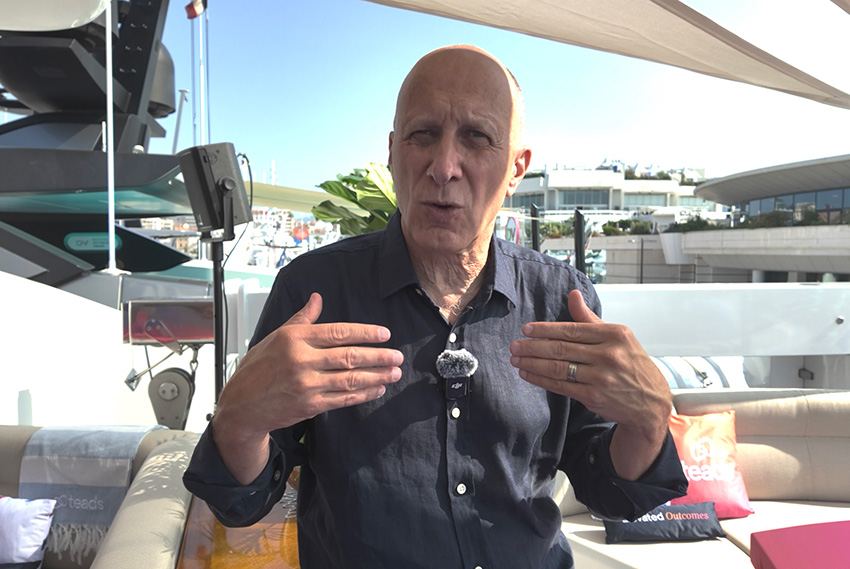Advertisers warn news media still too risky


Analysis
One of the most consistent topics along the Croisette during the 2025 Cannes Lions International Festival of Creativity has been the existential threat to quality news providers in an era of geopolitical turmoil and civil unrest.
The impact risk-averse brands are having on the commercial performance of the world’s news media is a recurring bone of contention among international marketers, agencies and media owners.
In the spring, a Warc report revealed that global adspend directed towards news brands has fallen by a third in the past five years, representing a loss of $16bn.
Speaking on RTL Beach, Caroline Proto, director of global media at Luxottica, whose portfolio includes Ray-Ban and Oakley, was clear-eyed in her evaluation of the marketplace.
“So we are spending less [on news],” she said. “I think, given the current climate as a brand, it is more of a risk than it’s been in the past. It’s something we need to be cognisant of, but I also think we recognise that it is [still] where people are.
“And so it’s definitely a priority, but we need to figure out how do we stabilise based on the current culture we’re in?”
Luxottica, now part of EssilorLuxottica, spends approximately $400m annually on media, but Proto admitted concerns over brand safety and the use of unsophisticated keyword filter lists has seen the group pull back from all types of news environments.
“There’s so much urgent news that while we might have placed ads in a very safe, local news story, something could happen on a dime that means our brand is now next to something that is not safe for our brand affinity,” she explained.
“There’s less control of the environment, I think. It was a little bit more predictable in the past — and that is where the concern is. It’s not a risk with our current dollars that we’re willing to take.”
Proto added: “Our budget is already lower than we need it to be, so to potentially risk that negative brand sentiment [around news], we’d rather just go where we know it’s safe.”
In the same session, Gordana Buccisano, global brands strategy director at Reckitt, the health, hygiene and nutrition group, agreed risk around news remains too high.
“We’re in the business of building brands; reputable brands, meaningful brands,” she said. “When you think about it, health and hygiene is something that actually adds to everyday living… so risking something that we’ve built for the sake of, you know, a couple of seconds and [potentially] negative exposure — that would be massive for us.
“So it’s not just a question of budget; it’s very much a question of ensuring the dollars that we spend actually appear in the right brand environment. That’s very important for us.”
Buccisano went on to admit the FTSE 100 business, whose brands include Dettol, Durex and Harpic, pulled all of its traditional adspend around the US elections last year.
“The reason why we went dark during news last year is because we thought it was a really terrible year,” she continued. “There was a strategy and we thought, you know, once that’s over, we can — and we have actually started to reintroduce news.”
The challenge for publishers
Such marketing decisions are having a notable impact on publishers, which are already fighting for time and attention on many fronts.
At a panel session on Teads’ yacht, Christoph Eck-Schmidt (pictured below, left), global commercial officer and chief marketing officer at Axel Springer, revealed that “after years of heavy digital investment” in Bild — which he called the “most important journalist media brand in Europe, with more than 40m active monthly users” — “30% of our inventory is blocked”.
Jesse Waldele (pictured below, second from left), senior vice-president of digital operations and client success at Dow Jones, said that half of her portfolio, led by The Wall Street Journal, is currently on “blanket blocked lists” among advertisers.
“So that’s 50% of a global audience that you’re not engaging and, with premium brands like Wall Street Journal, those are crucial consumers that you [brands] are unable to reach to achieve business outcomes,” she noted.

Combating negative perceptions
Meanwhile, speaking on an RTL panel, Vanessa Otero, CEO of Ad Fontes Media and creator of the Media Bias Chart, explained how she is trying to combat the blacklisting of news sites by providing advertisers with an easy-to-understand, reliable news rating system.
Ad Fontes uses a systematic approach to content analysis in which a team examine and categorise news content to create data that is useful to news consumers, educators, marketers and even publishers themselves.
The business consistently debunks the idea that advertising around quality news is risky for brands. Advertisers leaning in to high-quality news regularly report lifts across many KPIs, including better efficiency, higher cost per acquisition and conversion rates.
“I mean, ‘news’ performs — period,” Otero declared. “We help advertisers activate on high-quality news. And what we mean by high quality is highly reliable and minimally biased.”
Separately, Stagwell, through its Future of News initiative, has also been arguing that advertising on news brands, regardless of content, is brand-safe.
Advertising adjacent to quality news content is brand-safe regardless of topic
How is social media avoiding the filter lists?
This week’s industry takeover of Cannes coincided with the release of the Digital News Report by the Reuters Institute for the Study of Journalism. The 14th edition is based on data from six continents and 48 markets.
Among the findings, despite being in an era of uncertainty when evidence-based and analytical journalism should be thriving, there has been a continued acceleration in people consuming news via social media and video platforms.
Social media news use has risen sharply (up six percentage points), but there was no “Trump bump” for traditional sources. Influencers are, in some countries, playing a significant role in shaping public debates.
One-fifth (22%) of respondents in the US say they came across news or commentary from popular podcaster Joe Rogan in the week after the presidential inauguration, including a disproportionate number of young men.
The report claimed that the result is a supercharged, “fragmented alternative media environment” containing an array of podcasters, YouTubers and TikTokers.
But how are these social platforms avoiding the same blanket blocking as publishers?
“This is exactly what we are fighting very hard, to ensure that it’s a fair competition between social media and also our journalistic breadth, because it has to be about quality,” said Eck-Schmidt.
He believes quality news publishers are being unfairly penalised because “they are very visible”, whereas on social media you cannot see all of the millions of feeds and interactions, so marketers mistakenly think brand safety is not such a problem.
Eck-Schmidt recalled his team finding ads from a client, which had stopped advertising on Bild after a terrorist attack in Germany, running ads on Meta and TikTok.
He continued: “I told the CMO you’re stopping ads on the news platform where journalists inform people about what’s happening in the world but, at the same time, you are doing nothing where people are commenting and even, in some instances, supporting what’s happening just one click away. It’s very strange.”
Isn’t this what media planners were born to advise on? From an agency perspective, Kara Osborne, UK and Ireland CEO of UM, confirmed that such concerns over brand safety in today’s news environment were indicative of the marketplace.
She noted: “And yet all the research says that brands that advertise around news have double-digit improvements on health, trust and the ability for content to really work for them.”
Osborne saw an opportunity for brands that are able to figure out how to be different within their category and do something newsworthy, resulting in earned media and shared media that will amplify their campaigns: “It’s not just about the dollars spent.”
She also admitted that this is a problem of the industry’s own making, driven by huge tech platforms and programmatic buying.
“I think we’ve basically said ‘every impression is equal’ and we all know that it’s not,” Osborne said. “That has been done because the measurement shows you that type of thing and yet we know context is everything. And when we get the right context, it means your brand can thrive and do much better.
“I think we also use a lot of adtech that promises benefits — and I say this coming from an analytics, data and product background before my current role — we’ve said that the tech can do a lot of things that it can’t do. It can do very blunt things.”
AI opportunity
There is some reason for optimism, with many executives this week welcoming the arrival of new AI tools that can help to better target audiences and avoid blanket bans based on broad terms.
Proto said there is “a ton of opportunity”, despite currently having lots of effective publishing partners being flagged for “news” that the company is having to manually move out of blocked media.
New AI tools promise the next chapter could be more positive for the news industry, with greater abilities to finesse filters, keywords and placement, as well as the arrival of more personalised services.
The Digital News Report confirmed how AI is drastically changing the kinds of personalisation that are potentially feasible. Generative AI now makes it technically possible to personalise news formats according to the needs and preferences of individual users, while also enabling entirely new possibilities, such as chatbots that can answer news-related questions.
That said, how these developments will be commercialised at scale still remains to be seen.

Another voice in the mix this week has been David Kostman (pictured above), CEO of the newly expanded programmatic ad platform Teads. He told The Media Leader that he believes the technology is reaching a point where brands can feel safe being around news content through the use of more granular filters.
Kostman added: “What is happening today is that there is sometimes an overall block on so many sections and so many pages of the greatest news publishers of the world that it is creating anomalies.
“I think it’s something that we should all be very focused on, as an industry mission and as an individual. I want my kids to get news from trustworthy, authentic publishers. It could be from any side of the political spectrum, so long as it’s professional editorial that opens their minds to other opinions.
“I think it’s critical for us, as an ecosystem, to do as much as we can to support journalism in this world.
“And for advertisers, I think the return on investment when it comes to adspend is there. Many studies show there’s big opportunities of reaching incremental audiences that you cannot reach anywhere else at a great moment of attention through news.”
Many battle-hardened publishers will be hoping AI really can kick-start a new era for news.
Arif Durrani is global content director at Reuters Plus. He is also a media consultant and freelance writer
is global content director at Reuters Plus. He is also a media consultant and freelance writer




